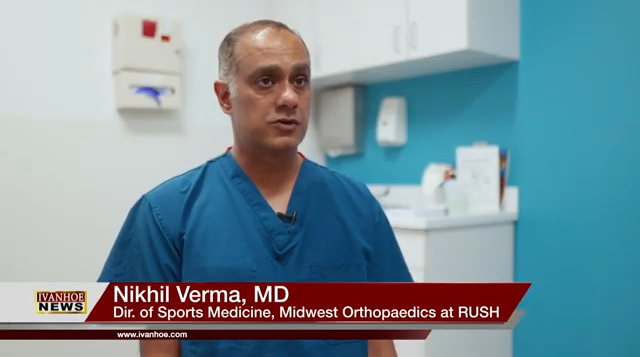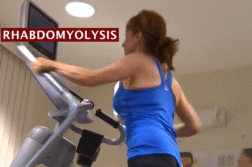Nikhil Verma, MD, Director of Sports Medicine at Midwest Orthopaedics at Rush talks about reverse shoulder surgery.
Interview conducted by Ivanhoe Broadcast News in 2024.
We’ve heard a lot about the knee replacement and now we’re hearing more and more about shoulder replacements. Why do you think that is?
Verma: Shoulder replacements are the third most common replacement that people undergo in the United States, second only to hip and knee. The numbers are actually not small. There’s about 500,000 shoulder replacements that get done in the United States on an annual basis. But I think the reality is, like all orthopedic conditions, people are living longer and they’re living active lives longer, which means that these conditions tend to pose symptoms and cause them to present for care.
What happens to shoulders? What’s going on in the shoulder that is causing them to be replaced?
Verma: So arthritis is the general condition for shoulder replacements or hip replacements, or knee replacements. That basically means that they’re losing the cartilage, which is the bearing surface of the shoulder. When you lose cartilage, it causes many problems. These include stiffness, pain, loss of function. Nighttime discomfort is a big one with shoulders. But basically, you’re starting to get a situation where the two bones are rubbing together in a bone on bone situation, which is when a replacement is indicated.
Are you able to connect the dots with some of your shoulder replacement patients? Are there certain sports or certain occupations that would lend a person more towards needing one?
Verma: The big one that we associated with is really heavy lifting. So I always tell my patients we weren’t designed to walk on our shoulders, we were designed to walk on our ankles, our hips, and our knees. Which is why the cartilage in shoulders is much thinner than the cartilage in the hips and the knees. So when people are doing significant lifting, like power lifting, for example, where they’re lifting well above their body weight, those are conditions that we do associate with fairly early onset and rapid progression of arthritis.
And like Martha, she’s a nurse and she was lifting large people.
Verma: Martha’s is probably multifactorial. There’s a genetic predisposition, she has arthritis and other joints. She’s lived an active lifestyle. She’s certainly right smack dab in the middle of the age range that we associate with arthritis. And she has a fairly generic form of osteoarthritis that led to her to seek treatment.
A shoulder replacement can be life-changing, right?
Verma: I think any replacement, including shoulder replacements are life-changing. And the fact of the matter is the reason we’re doing replacements is to improve quality of life. Specifically, for shoulder replacements, the main issues that we see our patients have trouble sleeping, and because our shoulder is used to interact with the world, they start losing their ability to do things from a recreational basis, from a work basis, and then eventually, they get to the point where they struggle to do even normal activities of daily living – combing their hair, brushing their teeth, washing their back – just general things that we take for granted become challenging.
There is a subset of patients which I understand is growing, for whom a typical shoulder replacement is not the answer. Tell me about that.
Verma: When we do a traditional shoulder replacement, we simply replace the ball in the socket, but we’re still depending on all of the muscle structure, particularly the rotator cuff that surrounds the shoulder in order to reproduce function. The problem is, as we get older, in addition to arthritis, patients also have pathology of the rotator cuff, and if you have a combination of an arthritic shoulder as well as a rotator cuff that’s dysfunctional, it means that the failure of a traditional replacement or incomplete functional recovery following a traditional replacement has been a problem that we’ve dealt with. The way that we solve for that problem is a new implant that’s called a reverse shoulder replacement. And literally what a reverse shoulder replacement does is it puts the ball where the socket goes and the socket where the ball goes. And what that does is it allows the shoulder to become a constrained joint so that the big muscles on the side of your shoulder are now able to substitute for the rotator cuff. What that allows us to do is to get very high levels of function, even in patients that have rotator cuff pathology.
When you think back about Martha, you had mentioned that she was the perfect patient for reversed shoulder replacement. Can you tell me why, what you remember about her when you first met her, what your advice was to her and how she did?
Verma: So I think she was perfect in many ways. Number 1, is she’d gone through all of the conservative options that were available and her disease was progressing to a point where it was, in fact, impacting her quality of life significantly. Number 2, is she had a very arthritic shoulder. She had very little cartilage left. It was essentially a bone on bone situation. She was stiff, she was painful, and she was having nighttime discomfort. Number 3, is she was a candidate for a reverse because she had rotator cuff pathology. So if we had done a traditional replacement, we probably wouldn’t have seen the same range of motion recovery and functional recovery that we saw with a reverse replacement. And the bonus to that, that many patients really like is the fact that the rehab following a reverse replacement is much more rapid than following a traditional replacement, which is a big deal in the patient population that we’re dealing with.
What’s the difference in recovery between a reverse and a traditional?
Verma: Amazingly quick with a reverse. With a reverse, you’re in a sling for about four weeks, we start motion actively, immediately after that patients are generally done with PT at about three months. In a traditional replacement, we’re depending on the rotator cuff function and we have to repair the rotator cuff as we’re leaving the shoulder because we have to take down a portion of the rotator cuff to enter the shoulder. So we have to go much slower with the rehab to make sure that that heals properly. It’s typically about a six month recovery.
I read somewhere that doctors, in general, are doing more reverse procedures, is that the case, and why do you think that is?
Verma: So the reality is that it is the case. There’s about 50% of shoulder replacements now are done with reverse implants, and it’s for a number of somewhat complicated reasons. One is we can deal with problems where the bone isn’t as quite as good as we needed to be or there’s deformity of the bone. It’s much easier to make up for those situations with a reverse implant. So technically it makes our job much easier and it extends the life of the processes. Secondly, as we talked about is, patients are living longer, they’re getting older, they’re living active lives longer. So it’s much more common to encounter patients that have both arthritis and rotator cuff disease. And finally, we just have had greater and greater experience with the prosthesis and we’re becoming much more comfortable in terms of the success rate and the longevity. And frankly, most of the studies now would suggest that both implants have similar durability and similar functional recovery when used appropriately.
END OF INTERVIEW
This information is intended for additional research purposes only. It is not to be used as a prescription or advice from Ivanhoe Broadcast News, Inc. or any medical professional interviewed. Ivanhoe Broadcast News, Inc. assumes no responsibility for the depth or accuracy of physician statements. Procedures or medicines apply to different people and medical factors; always consult your physician on medical matters.
If you would like more information, please contact:
Ann Pitcher
Sign up for a free weekly e-mail on Medical Breakthroughs called First to Know by clicking here




